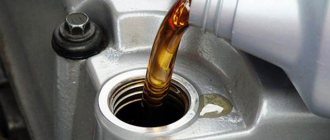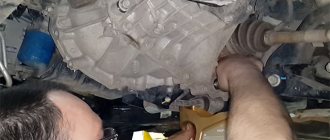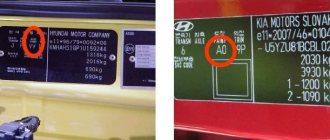Tools
To make your work more convenient, prepare everything you need in advance.
Namely:
- set of socket heads;
- screwdriver with Torx bit size 25;
- long-nose pliers or another type of pliers with thin, elongated jaws.
In addition to the tools you will need:
- oil;
- filter;
- sealing ring;
- container for draining oil.
The filter is indicated because when changing the lubricant in an automatic transmission, it is recommended to change the filter as well.
A set of automotive tools in a suitcase
Complete oil change in automatic transmission
A complete oil change is performed every 70 thousand km.
or in case of automatic transmission repair. Most often, the fluid is changed at a service station during a routine inspection, but the driver can do this work with his own hands. For convenience, the car is driven into a pit.
The procedure for a complete oil change in an automatic transmission of a Volkswagen Passat:
- Warm up the engine for 10 minutes. This is necessary so that the liquid pours out faster;
- The pallet protection is removed;
- An empty container is placed under the drain;
- Within 30 minutes, the solution is drained from the system;
- There are special magnets on the inside of the tray to collect dirt. They need to be cleaned, together with the oil filter;
- Afterwards all gaskets and seals are checked. If necessary, parts are replaced with new ones;
- Next, new oil is poured in.
After changing the fluid, you should start the engine and change gears. This way the liquid is smoothly distributed throughout the system.
Choosing the right oil
In general, to avoid unnecessary troubles, replacement should be done regularly. According to general recommendations, for normal operation of the automatic transmission, this should be done after 100 thousand kilometers for the first time. Then every 50 thousand kilometers. In order to determine exactly how often this procedure needs to be performed in your Volkswagen Passat B6, you should refer to the description.
However, if the automatic transmission begins to operate intermittently, a lubricant change may be required earlier. A signal that the time has come can be the loss of any gear or simply jerking when switching.
Transmission oil ESSO ATF LT 71141 1l
For automatic transmissions, according to general recommendations, you can only use a lubricant that is suitable for automatic transmissions. The best result will be if you fill it with the one recommended by the manufacturer. It is also possible to use universal oils, which work well in some cases. From this series for Volkswagen Passat B6 you can use Vavoline Max Life.
When to change
Many drivers mistakenly believe that it is not necessary. Actually this is not true. After 80 thousand kilometers, this procedure must be carried out. They don’t want to change the lubricant mainly because this service costs a hefty sum at any car service center. But you can change the oil in a Volkswagen Passat B6 automatic transmission yourself, without the help of a specialist. The timing of the procedure is determined by the following reasons:
- appearance of noise;
- heavy gear shifting;
- deterioration of the vehicle's dynamic performance.
All these situations indicate problems with the automatic transmission. In most cases, it is enough to replace the old product with a new one. Since metal shavings appear in lubricants that have been used for a long time due to the friction of transmission parts. These chips significantly accelerate the wear process of other components. You can determine the quality of the oil used using a dipstick and a simple white rag. To do this, run this rag along the dipstick. If small black particles remain on it, then it’s time to change the lubricant.
Step-by-step replacement instructions
If a complete oil change in an automatic transmission is a complex process, then a partial one is quite simple.
It does not require special complex devices and can be produced independently.
Automatic transmission in Volkswagen Passat
- Before you start, it is recommended to warm up the car engine a little and then turn it off. The shift lever must be set to position “P”. After this, you can proceed directly to changing the oil.
- To gain access to B6, you must first remove the engine protection housing.
- Next, unscrew the screw plug.
- We unscrew the drain tube and drain the waste liquid into some container.
- The next thing is to replace the filter. First, we take out the old filter and install a new one.
- Now install the drain tube and clamp it only with your hands for now.
- Fill in about three liters of oil and start the engine. Here you need to change gears, holding each gear for 5-10 seconds. At the same time, do not forget to hold the brake pedal. When all positions have been passed, turn off the engine.
- Now you need to add the remaining oil. In general, it will be necessary to fill the automatic transmission with the same amount as was drained.
- At the end, tighten the screw plug and install the protection.
That's it - it's done. This does not take much time, but can prevent serious car damage and expensive repairs.
Topping up oil
In order to add lubricant to the normal level in the Volkswagen Passat B5 automatic transmission, we will need all the tools listed above. If you find a shortage using the dipstick, then follow these steps:
- Remove the lower engine protection.
- Remove the oil pan.
- Using the dipstick, determine how much oil needs to be added.
- Add new product to the automatic transmission using a hose and funnel.
As you can see, in a few steps you can easily add oil to the automatic transmission. The process will not cause difficulties even for an inexperienced driver.
Video “How to evaluate the quality of fluid in an automatic transmission”
Find out from the video a simple way by which you can evaluate the quality of oil in an automatic transmission.
What do you recommend for the Volkswagen Passat?
There are no clear recommendations from the automaker regarding the need and frequency of replacing transmission fluid in the Volkswagen Passat. The reason for topping up or completely updating the lubricant may be incorrect operation of the machine. A motorist who notices atypical behavior of the gearbox (delays, jerks when shifting gears, etc.) should check the level of working fluid in the device.
When should you change the oil in the Passat B5 automatic transmission?
Objective reasons why you have to act contrary to the manufacturer’s recommendations may include:
- When changing gears, strange jerks often occur, or sometimes it is difficult to shift.
- Also when jerks occur spontaneously when the car is moving, or if the car does not immediately respond to changing gears.
- Sometimes strange behavior is noticed due to insufficient volume of lubricant in the system, and because of this it is necessary to top up or make a complete replacement, which is more important.
- If the control plate becomes dirty, you should immediately clarify that replacing the lubricant alone will not get rid of it. You will have to wash the stove itself, and doing this yourself is even more difficult.
If you forget about the manufacturer’s recommendations, due to the fact that the conditions of Russian roads and other factors fundamentally change the entire operating system, the initial oil change in the Passat B5 automatic transmission should be carried out after 100 thousand kilometers, and further after every 50 thousand kilometers.
In the case of the symptoms described above, the oil in the automatic transmission is changed even more often, and in addition, both changing the lubricant and flushing the box should be carried out with any type of automatic transmission repair.
How to check the automatic transmission oil of a Volkswagen Passat
The fluid level in the Passat automatic transmission is checked when the fluid temperature reaches from +35 to 45 C, depending on the type of mechanism. You can create conditions for testing by waiting a short time after starting the engine. Warm-up measurement is carried out using a diagnostic scanner. If you do not have the appropriate equipment, it is recommended to carry out the work at a VW service station.
So, the required temperature has been reached. How to check the oil level in a Passat box
? By leakage from the overflow tube. The presence of the optimal amount is indicated by the flow out of the corresponding hole at approximately 1 drop per 1 second. A slower flow of drops indicates the required topping up, a faster flow indicates draining.
How to check the oil in an automatic transmission Passat B6?
The work order is as follows:
- The car is installed on a flat horizontal surface.
- The lower mudguard of the power unit is removed.
- The automatic selector lever is set to position P, and the handbrake is applied.
- The process is carried out with the engine running.
- The oil pan plug is unscrewed (gearbox temperature from +35 to +40 C).
- If necessary, the product is topped up.
- The plug is screwed back in. Before the temperature exceeds +45 C, the part is tightened with a torque of 15 Nm.
- The lower mudguard is installed.
Which ATF to use
Motorists who know how to check the oil in a Passat B6 box
, should also know what products need to be used to top up Volkswagen. Having determined that the automatic transmission needs a fresh portion of lubricant, you should stock up on the necessary products.
Owners of the Volkswagen model are recommended to buy a new original ATF fluid, its catalog number is G055025A2
(packed in a 1 liter canister). The required amount of refueling should be clarified using the vehicle's VIN number. The mixture remaining in the package can be stored until the next filling.
Volkswagen Passat B6 is a German business class car, which is now very popular in the secondary market. Despite the high quality of workmanship, the machine requires timely maintenance. Fortunately, in the absence of a free warranty, some repair procedures in the case of the VW Passat B6 can be performed independently. For example, change the oil in the gearbox. Let's consider this process in detail using the example of a car with an automatic transmission.
Volkswagen does not recommend changing the fluid. This is due to the fact that factory lubricant is initially designed for the entire service life of the car. However, the manufacturer does not take into account the harsh Russian conditions, in which the fluid replacement schedule is reduced to 30-40 thousand kilometers. The sooner you change the oil, the better it will be for the gearbox. Under the influence of unfavorable factors, the fluid quickly loses its beneficial properties and is no longer able to cool the automatic transmission components, as well as prevent their premature wear. As a result, the gearbox will sooner or later fail if measures are not taken in a timely manner.
Signs that you need an oil change may include the following:
1. Jerks and unclear gear shifting 2. Drop in engine power 3. Noises, knocks and vibrations in the automatic transmission 4. When checking the condition of the oil, the fluid smells burnt and turns black over time
What oil to use
Despite the fact that car manufacturers claim that there is no need to change the oil in automatic transmissions, it must be done. This is said not only by experienced drivers, but also by factories that produce transmissions. As a rule, the recommended amount of product for a specific automatic transmission is indicated on the dipstick. But it is not at all necessary to adhere to this recommendation. The modern market is represented by several proven manufacturers. They all produce quality products. Here is a list of the most common ones in the VW Passat B5:
- Liqui Moly;
- Castrol;
- Lukoil;
- Mobil.
This is not a complete list. But drivers use oils from these manufacturers most often. If you have no desire to purchase these particular products, then pay attention to the presence of certificates and GOST standards from little-known brands. If there are none, then it is best to refrain from purchasing such funds.
Let's start changing the oil
- Preheat the engine until the automatic transmission oil reaches operating temperature.
- With the engine on, operate the gearbox in all modes
- Turn off the engine, then place the car on a viewing platform with full access to the bottom of the car. This could be an overpass, an inspection hole, a lift, or, in extreme cases, a jack will do
- The gearbox is switched to park mode P
- Removing the pan - this procedure is necessary to gain access to the oil filter, which is disposable and needs to be replaced. So, to remove the pallet, you must first pull out the protection, behind which the pallet itself is hidden. Please note that there is a drain plug on the pan. We place a container under it into which the waste liquid will flow.
- The plug is unscrewed, after which we observe the process of oil flowing out. But in this case, only half of the total volume of liquid will flow out
- So, we continue to remove the pallet. To do this, use a hex wrench to unscrew all the bolts holding the pan. After removing the pallet, pay attention to the magnets located on the inner surface of the pallet. They are designed to attract metal shavings. The surface must be thoroughly washed, cleaned, degreased and wiped dry. We must try to completely clean the magnets if possible, since the presence of chips can cause premature wear of gearbox components
- After dismantling the pan, access to the oil filter opens, remove it and replace it with a new analogue
- The next step is to remove the wire ends coming from the control plate. The wires must be taken to the side, having first freed them from their fixation. At this moment, the gear selector should be in its original position
- We proceed to dismantling the control plate. To do this, you will need Torx tools to remove the 17 bolts holding the control plate in place. In this case, they must be unscrewed in a certain sequence. Each bolt is numbered. So, first remove bolt No. 17, then No. 16, then No. 15 and so on, until bolt No. 1
- You must remove the slab carefully, holding it so that it does not fall off. The plate is removed from the box, after which it is washed and cleaned of oil stains
- Let's pay attention to the design of the control plate. It includes five component units. The stove is equipped with a massive plate with balls and jets, which must be washed and wiped dry
- Disassemble all components of the stove, wipe and dry them
- The next step is to dismantle the plate, which also needs to be thoroughly washed and dried. Balls, jets and springs are removed with thin tweezers. It is advisable to lay them out in such a way as not to get confused when reinstalling them. Each element is washed in gasoline, then wiped with a dry, clean towel
- Wait until all disassembled parts dry, if necessary. Then we move on to the next stage
- Assembling the control plate, then installing it back into place. The plate should be screwed in the reverse order - from No. 1 to No. 17
- Connect and secure the wiring
- Install a new oil filter
- We install the pan, having first replaced the gasket in it. The drain gasket also needs to be replaced.
- After securing the bolts, we begin to fill in new oil.
- To do this, unscrew the corresponding hole into which new lubricant will be poured.
- Pour in fresh oil in a certain amount. It is necessary to pour until liquid begins to appear from the hole. At this point, stop pouring and close the plug.
- Start the engine and let it idle for a few minutes. To circulate oil through all automatic transmission channels, you need to operate the gearbox in all modes
- Stop the engine and add fluid if necessary.
- Turn on the engine, make a short trip around the town of 5-10 kilometers, then check the level again. At this point, the process of changing the oil in the automatic transmission of the Volkswagen Passat B6 has been successfully completed.
Partial oil change in automatic transmission
There are two ways to replace the fluid in ATF - partially and completely.
Partial oil changes are recommended when minor transmission malfunctions are observed. Most often, the liquid is drained by 40% and replaced with a new solution. This is how the oil is renewed and its validity is extended.
Procedure for partial fluid replacement:
- Initially, you need to turn off the engine and raise the car using a jack;
- Next, you need to remove the pan protection;
- Unscrew the valve of the drain tank;
- Substitute the container;
- Pour out as much liquid as possible;
- After this, the oil filter is cleaned and a new solution is filled to the maximum mark.
The required amount of oil is 2 liters.
Video instruction
We will show you how to change the oil with your own hands in an automatic gearbox of an Aisin 09G automatic transmission of a Volkswagen Passat B6 (Volkswagen Passat B6), produced in 2007. The owner complained about poor gear shifting; the car had covered 65,000 km since the last replacement. When they began to drain the waste, they saw the oil in a terrible state, it was black like fuel oil. After our partial replacement, automatic transmission shifts became smooth, the box stopped kicking.
Remove the engine protection. Using an M5 hexagon, unscrew the pan plug:
And drain the used oil. After this, we unscrew the pallet itself along the “perimeter”. We lost about 2.5 liters of waste. Then unscrew the level tube using an M5 hexagon:
Unscrew the tray. We unscrew the oil filter, be prepared for another liter of oil to drain out:
We install a new filter from Vaiko, spare parts catalog number V10-1878:
It comes with two cork gaskets. We wash the tray with magnets, install a new gasket on it, also wipe its seat and tighten it.
On the right drive side, in the upper part, in the place where the T55 Torx bit is put on, this is the filler plug:
We unscrew it, insert a hose there and pour new oil on top through a funnel with the car turned off. We do this until oil runs through the drain tube. We fill in Mobil ATF 3309. We start the car and continue to fill it further. At this time, we turn on the automatic transmission on the brake and drive it in all modes for 5 seconds. We wait until the oil stops flowing in parking mode and starts dripping, and tighten the plug.
Video of changing the oil in an automatic transmission Volkswagen Passat B6:
Backup video on how to change the oil in an automatic transmission Volkswagen Passat B6:
The video shows only all the most important procedures; if you count the total time spent, it took approximately 3 hours to complete the entire work. Remember that you need to pour 6.5 liters of oil into a “dry” box. With a partial replacement like ours, we fill in approximately the same amount that was drained; in the end, using the replacement method, we poured in about 7 liters.
The practice of operating a Volkswagen Passat B6 car proves that replacing the transmission fluid in an automatic transmission should be carried out at a mileage interval of 50,000 km. The duration of operation of the automatic transmission directly depends on the regularity of this procedure and the quality of the materials used. The frequency of lubricant changes, the selection of transmission substances, and the technical details of the process are related to the specific model of the Volkswagen Passat line.
How to fill an automatic transmission with oil
Of course, it will not be possible to completely replace the lubricant on your own in the absence of special equipment, however, even a partial update will have a better effect on the operation and characteristics of the Volkswagen Passat automatic transmission.
After all the preparatory work has been carried out, you can begin the replacement itself and it consists of several very important stages.
First, the plug in the form of a bolt is removed from the oil filler hole and a small plastic bottle with a built-in hose is prepared. Next, this kind of funnel is inserted into the hole and new oil is poured into it until it stops. As soon as the oil flows, start the engine and start shifting gears. The selector should be switched to all available modes and at each of them a short pause should be made from 2 to 4 seconds.
After this, the engine is turned off, oil is added and everything is repeated, but this time in a more enhanced mode with the inclusion of all available modes that the box has. At the end of these steps, the lubricant consumption is on average 6-8 liters.
The oil change process does not end there. The next step is to add lubricant to the required level and this is done according to certain rules:
- The engine must be started.
- The selector switches to parking mode.
- Warming up the engine should be at least 35 and no more than 45 degrees.
If the temperature is higher than normal, then at a higher degree there will be actual underfilling, and at a lower degree, accordingly, overfilling. It is necessary to fill in the lubricant until the product begins to overflow and as soon as the first drops of lubricant are dripped in, the event is considered over.
This is actually how this tedious and responsible operation of changing transmission oil in automatic transmissions on Volkswagen Passat B5 cars is carried out. Provided that the recommendations are strictly followed, full operation of the box is guaranteed without delays, shocks and other negative phenomena.
When might an oil change be necessary?
Starting from the Volkswagen Passat B5 generation, the manufacturer recommends not changing the automatic transmission fluid. It is assumed that the transmission oil resource should be sufficient for the entire service life of the vehicle. However, due to many circumstances, replacing the lubricant may still be necessary.
The reasons for changing the oil are various violations of the automatic transmission operating modes:
Even with normal operation of automatic transmissions installed on cars of the 5th generation (Volkswagen Passat B5) and older, according to general advice, the oil is changed for the first time after 100,000 km. Then it is recommended to repeat this procedure every 50,000 km. And if one of the described symptoms occurs, the transmission fluid should be replaced earlier. Flushing the automatic transmission and changing the lubricant may be required during partial or complete repair of this unit.
Timing for oil changes in Volkswagen automatic transmissions
In a working automatic transmission mechanism, many parts constantly interact, which, under the influence of high temperatures and pressure, can wear out and become unusable. To prevent this from happening, Volkswagen Passat car manufacturers pour a special process fluid into the automatic transmission.
The ATF mixture performs a number of essential functions to protect the mechanism:
- effectively lubricates parts, preventing friction between them;
- exerts the necessary pressure force;
- distributes temperature;
- removes dirt and much more.
As a rule, a synthetic solution poured into a Volkswagen Passat does not lose its properties over time. However, the mixture can wear out due to failure of the automatic transmission mechanism: clutches, cylinder, pistons, steel discs, etc. The solution becomes clogged with the remains of mechanical particles, as a result of which it cannot fully perform its functions. Moreover, the mixture forms a blockage, which leads to complete failure of the automatic transmission.
The first signs of the need to change the fluid in the automatic transmission
Volkswagen Passat cars are:
- frequent slipping of the gear;
- mode lock;
- sensation of shocks or noises when working with automatic transmission;
- darkening of the solution and a burning smell.
If you observe at least one of the above signs, it is necessary to urgently diagnose the car.
The ATF mixture can fail due to aggressive influences such as:
- frequent car slipping;
- long driving in low gears;
- increased engine speed;
- overheating of the motor, etc.
Which lubricant is best to use and how much is needed?
Before a planned or forced replacement is carried out, you need to stock up on transmission fluid. Only the original is strongly recommended for use. Its catalog number is G 052162A2.
However, such oil may not always be at hand, and even in sufficient quantities. Then, with extreme caution and accuracy, you can pour transmission fluid from other manufacturers into the Volkswagen Passat automatic transmission. These may be ESSO ATF LT 71141 or MOBIL LT 71141.
In any case, you can only use the oil that is recommended for automatic transmissions. As a last resort, turn to a series of universal oils. If problems arise with the Passat automatic transmission, Vavoline Max Life helps out.
Changing the lubricant in an automatic transmission is accompanied by the procedure of replacing the old filter with a new one. Taking into account this circumstance, it is better to acquire 9 liters of transmission fluid. The remainder can be used for topping up.
What lubricant is relevant for the Passat B5 and what is needed for replacement
Before you start directly changing the oil, you must immediately prepare everything that may be needed during the process:
- A basin or tank for draining waste.
- Hex keys from No. 8 to No. 17.
- Thin tweezers.
- Set of torx bits from No. 25 to No. 30.
- To fill the oil you will need a thin soft hose.
- Torque wrench.
- A little gasoline.
- Rags.
- Pan gasket.
- Automatic transmission filter.
- And of course, the oil itself.
It’s worth saying right away that all of the above is necessary solely to replace the lubricant. Additionally, other accessories may be required, for example a set of keys for removing the pallet protection, etc.
Therefore, if you approach such an important event on your own, then only in a room with a full set of tools and an inspection hole.
Regarding the lubricant product itself, it is strongly recommended to use original oils corresponding to G 052162A2 for automatic Passat gearboxes.
In cases where it is not possible to find the original, the use of other lubricants in the form of ESSO 71141 or MOBIL LT 71141 is allowed.
The total volume of production is 9 liters + - and even if a little oil remains even during the replacement, you can remove it and add it at the next replacement.
The procedure for performing work independently
Completely replacing the lubricant in a Passat automatic transmission is not an easy process. It is possible to carry out a partial (incomplete) lubricant change independently and without complex special devices. But even a not completely updated transmission substance can have a beneficial effect on improving the operation of the automatic transmission.
Before starting work, it is recommended to warm up the engine and go through all gear modes at short intervals. Then the car is immobilized in the inspection pit. The shift lever is set to position “P”. And only after this they begin to directly change the oil.
Dismantling the pan and removing the filter
- To access the automatic transmission tray, you need to remove the protection. The drain plug is unscrewed from the bottom of the pan.
- A container is placed under the drain hole to collect waste liquid. Only part of the transmission substance will flow out through this hole.
- Hexagon (
 unscrew the fastening bolts to completely remove the pallet. There are magnets on the inside of the pallet. They are designed to catch metal particles that are formed as a result of wear of automatic transmission parts.
unscrew the fastening bolts to completely remove the pallet. There are magnets on the inside of the pallet. They are designed to catch metal particles that are formed as a result of wear of automatic transmission parts. - The degree of wear of the mechanism elements is assessed by the amount of metal products. An increased amount of chips indicates a possible serious breakdown. The inside of the tray cover is thoroughly washed and cleaned.
- The filter is removed, secured with 2 bolts.
- The wire tips from the control plate are removed from the connectors. The bundle of wires is released from fixation and taken to the side.
- It is important to remember in what position the automatic transmission selector lever is located. During the assembly process, the link must be installed in its original position (as before removal).
Control plate: removal and further disassembly
- Using torx screws, 17 bolts are unscrewed that secure the control plate. It is important to follow the order. According to the diagram, bolt No. 17 is first unscrewed. Then they move according to the principle of the reverse sequence to bolt No. 1.
- Carefully holding the stove, remove it from the box. The inside of the box is thoroughly cleaned of any remaining liquid.
- The control plate combines 5 components. Additionally, there is a massive plate inside. Underneath there are balls and jets. All these parts will need to be washed and dried.
- The components are disassembled after unscrewing the fastening bolts. They are of different lengths. Therefore, you need to remember or mark the location of each bolt.
- After removing the 4 components, you can approach the plate. It is removed and washed thoroughly. The dried plate should be placed near the stove. Use thin tweezers to carefully remove the balls, jets and springs. It is better to place them on the plate in places corresponding to the installation. All elements are washed in gasoline and wiped dry.
Automatic transmission assembly procedure
After drying or removing gasoline residues, the slab is assembled. It is necessary to strictly follow the order of installing small parts in the appropriate places:
- the control plate is mounted in place, fixed with bolts in the order from No. 1 to No. 17;
- the selector link is installed in the same place;
- wiring is connected and fixed;
- a new filter is installed;
- the pan gasket is changed (it is advisable to change the drain plug gasket);
- the pallet is fixed.
Filling the transmission substance
Filling of a new transmission substance is carried out in several stages:
At the final stage, the amount of transmission fluid is brought to the desired level. To do this, the car engine starts and the gearbox lever is switched to parking mode (“P”). The liquid in the box needs to be heated to 35–45°. A low or high temperature will lead to underfilling of the transmission fluid or to its overfilling. The correctness of the work will be confirmed by the elimination of shocks or delays in the operation of the automatic transmission.
Automatic transmissions - maintenance and replacement of transmission fluid
The car manufacturer, the VAG concern, states in the accompanying documentation for Volkswagen cars that the transmission fluid (ATF) cannot be replaced. If this vehicle is operated on Russian roads, it is advisable to replace the lubricant every 40 thousand kilometers. Then the machine will serve for a long time without causing any complaints. If this condition is not observed, the following malfunctions may occur:
- while driving, when changing gears, jerking is observed;
- the car reacts to switching with a delay;
- The automatic transmission cannot shift to the desired gear.
The reason for this behavior may be not only the poor condition of the working fluid, but also its insufficient quantity or dirt getting into the control plate. Therefore, each case of non-standard behavior of an automatic transmission must be considered individually.
Which ATF to use when replacing
To partially or completely replace the lubricant in both types of automatic transmissions, ATFs that meet the requirements of VW G 052162A2 are used. The semi-synthetic working fluid Esso Type LT 71141 is recommended for use. It can be purchased at prices from 690 to 720 rubles per 1 liter. If it is not on sale, you can use it to replace Mobil LT 71141, at a price of 550 to 620 rubles. per liter
For a 01N gearbox with 4 gear levels, 3 liters of working fluid are required for a partial replacement and 5.5 liters if a complete replacement is carried out. In addition, about 1 liter of gear oil corresponding to VW G 052145S2 was poured into the main gear of the box. If the car has a 5-speed automatic transmission 01V, a partial replacement will require 3.3 liters of lubricant. For a complete replacement you will need 9 liters of ATF.
Procedure for replacing working fluid
The list of work performed when replacing ATF is similar to automatic transmission models 01N and 01V. For example, changing the fluid in box V01 is described. Before you begin, you need to prepare the tool and purchase a couple of components. Needed:
- pan gasket, catalog number - 01V321371;
- cleaning filter, number 01V325429;
- hexagons, sizes 8–17;
- heads for star-shaped torxes, sizes from 25 to 30;
- wrench with dynamometer;
- tweezers with fine tips;
- gasoline for washing;
- empty container for draining used liquid;
- small diameter hose for filling ATF;
- rags.
If you need to remove the crankcase guard, you may need additional keys. Next, the following sequence of actions is performed:
- The engine and automatic transmission are warmed up with a short drive, then the car is driven into an inspection hole or onto an overpass and secured with a parking brake.
- If there is a pallet protection, it can be removed.
- An empty container is inserted, after which the fluid drain plug in the automatic transmission pan is unscrewed using a hexagon to “8”. ATF is partially drained into the container.
- Use a Torx on “27” to unscrew the bolts securing the pan, after which it is removed.
- The remaining working fluid is drained. There are magnets on the inner surface of the tray that have chips stuck to them. The degree of wear of the box is assessed by its quantity.
- The automatic transmission filter is removed from the control plate. You must first place the container, as oil may leak from under it.
- All connectors suitable for the control plate are disconnected. The fixation of the wiring harness and the rotation sensor are removed.
- After assembly, the automatic transmission selector rocker should be in the same position as before starting work.
Working with the control plate
- Using Torxes, the 17 bolts that secure the control plate are unscrewed. The sequence of unscrewing the bolts is strictly regulated. You need to start with number 17, shown in the figure, and end with number 1.
- The plate is carefully removed. The internal cavity of the automatic transmission is freed from the remnants of the old ATF.
- The slab structure is carefully disassembled - the 5 components that make it up are unscrewed. The fastening screws have different lengths, so it is better to arrange them so as not to mix them up later.
- In the plate there is a massive plate, under which there are jets and balls. You should remove it very carefully so that the elements underneath do not jump out of their nests.
- After cleaning the plate, it must be placed with the inner surface facing out, next to the stove. The jets and balls from the plate are transferred with tweezers to the nests on the plate.
Assembling and filling oil
- Reassembling the control plate is done in reverse order.
- The control plate is installed in its place. All 17 bolts are tightened with a torque wrench with the same force - 8 Nm. Now the bolts are tightened sequentially, from 1 to 17.
- The selector rocker is installed in its place. The connectors with wires are connected, the harness is fixed. A new filter is being installed.
- A tray with a new gasket is screwed to the bottom of the slab. If there is a new washer for the drain plug, it is advisable to install it as well.
- The filler plug bolt is unscrewed. The tip of a hose connected to a plastic container is inserted into the hole.
- The working fluid is poured until it flows out of the filler hole.
- The engine starts and the brake pedal is pressed. The selector is briefly moved to all positions. This procedure should be repeated several times.
- The engine is turned off, ATF is added to the filler hole until it begins to flow out again. You need to check that about 7 liters of fresh fluid are filled into the automatic transmission.
- The engine starts again, the transmission warms up to 40–45° C. Then the gearbox selector is switched to parking mode (P). In this mode, with the engine running, the remaining lubricant is added. As soon as droplets of liquid begin to fly out of the filling hole, it means that the required level of working fluid has been reached.
Checking the transmission fluid level in the automatic transmission
Boxes N01 and V01 do not have dipsticks for measuring the oil level. In order to check its level in the V01 automatic transmission, you should drive the car into the inspection hole. Check the oil temperature by connecting a scanner or VAGCOM. It should be around 30–35° C, not higher. Then turn on the engine and switch the selector to position P. With the engine running, unscrew the drain plug. If the working fluid level is normal, liquid should flow out of the plug in thin streams. After this, you need to immediately tighten the drain plug without turning off the engine. If there is not enough lubricant, it will not flow out of the hole. In this case, you need to turn off the engine and add ATF.
Video: replacing ATF in automatic transmission V01 Volkswagen B5
Volkswagen Passat cars have an automatic transmission. According to the manufacturer's regulations, the working fluid in this mechanism is not replaced, since the automatic transmission oil resources must be sufficient for the entire life of the vehicle. Only adding fluid is allowed in case of leakage. However, it often happens that the solution must be completely drained and replaced with a new one, for example, when repairing automatic transmissions and troubleshooting. What kind of liquid to pour into the mechanism and how to do it yourself, we will consider further.
Repair stages
We carry out all transmission repair work in the following order:
- input diagnostics, which allows you to determine any faults that have arisen;
- dismantling the automatic transmission, its repair, as well as replacing worn components and parts that cannot be restored;
- installation of the repaired box in place;
- filling with branded transmission oil;
- output diagnostics, including computer testing, which allows you to verify the quality of the repairs performed and the absence of other malfunctions.
Volkswagen Passat B6 errors - Do-it-yourself car repair
With the help of fault diagnostics, car owners can independently find out if there are problems in the car’s electronics. Below are general recommendations for reading VW error codes of various model years.
A feature of all modern models of the Volkswagen concern is the absence of a self-diagnosis function on the instrument cluster and the display of error codes on the panel. To read existing faults on Volkswagen cars produced after 1995, a diagnostic cord and a program installed on a computer or laptop are used.
When diagnosing a Volkswagen car, you should remember that errors can be displayed on the computer in both ten-digit and hexadecimal format.
Many cars, for example, Golf 4 or Passat B5, use self-testing systems with information displayed in German or English on the instrument cluster screen. This function was first installed on 4th generation Golf cars in 1997.
No manipulation is required to read error codes. When the engine starts, all systems and control units of the vehicle are polled. If a malfunction is detected, information about it is displayed in text format on the screen and is supplemented by a flashing or lit indicator.
In this case, the signal can be yellow or red (high level of importance).
Messages of high importance are accompanied by a three-time sound signal, the rest - a single sound. For example, if the oil level drops, a message will appear and the icon with an image of an oil can will blink. If you cannot clear the error yourself (by adding oil, coolant or windshield washer fluid, or by filling the tank), then you should conduct computer diagnostics of the car, which will allow you to accurately determine the cause of the malfunction.
An example of an error indication on the screen, while the EPC icon is lit
On earlier machines (before 1995), errors can be read by a tester and a light that flashes a fault code.
Programs for reading errors
The most famous and widespread programs are:
- Vasya Diagnostic, which is compatible with all versions of the Windows operating system. The program has a Russian interface and works with various types of diagnostic cords, for example, VAG COM 409.1 (USB interface or COM port) or HEX-USB+CAN.
- VCDS software, which is an original product and only works with the HEX-USB+CAN cable.
- Russian-language VAG Tool, also working with HEX-USB+CAN.
- VDS-PRO, running under the MS-DOS operating system and reading data only via the COM port using a VAG COM 409.1 cord.
- VAG EEPROM Programmer, which has a small set of functions and works with VAG COM 409.1 of any type.
- VAG K+CAN Commander, a more advanced functionality of the previous program.
In addition, there are a lot of highly specialized programs for reading and correcting data in individual electronic units of machines. For example, in the instrument cluster or transmission control unit.
Carrying out diagnostics on an old Passat B3 is shown in the video from the author of AUTO repair/NA/knee.
Location of diagnostic connectors
Source: https://avto-voshod.ru/remont/oshibki-folksvagen-passat-b6.html
Consumables, tools, accessories
If you will be replacing the transmission lubricant yourself, then you should take care in advance of a complete set of everything necessary for this procedure. Supplies you will need:
- transmission oil;
- pan gasket (catalog number 01V321371);
- sealing ring;
- automatic transmission filter (catalog No. 01V325429);
- gasoline for cleaning.
- set of hex keys;
- screwdriver and removable torx bits;
- torque wrench;
- thin tweezers;
- small diameter rubber pipeline for filling oil;
- container for draining waste substances;
- clean rags.
Other keys may be needed (for example, to remove protection). It is best to carry out work on replacing the transmission fluid in an automatic transmission in an equipped garage with an inspection pit.
Changing automatic transmission oil VW Passat B6 (1.8 TSI BZB)
The oil was changed using an automatic transmission 09G of a VW Passat B6 (automatic transmission with the letter designation KGV).
Similarly, replacement is carried out on boxes with a letter designation: for 1.6 l engines - 85 kW FSI together with HXK, JUB, KGS; for 2.0 l engines - 110 kW FSI together with HFT, HVW, HXJ, JUC, KGT; for 1.8 l power units - 118 kW TFSI together with JYY, KGV; for 2.0 l engines - 147 kW FSI together with HHP, HRN, JUD, JZV, KGU).
Automatic gearbox 09G
| Letter designation | HXKJUB KGS | HFTHVWHXJJUC KGT | JYVKGV | HHPHRNJUDJZV KGU |
| Engine | 1.6 l - 85 kW FSI | 2.0 l - 110 kW FSI | 1.8 l - 118 kW TFSI | 2.0 l - 147 kW FSI |
Such automatic transmissions are installed on VW cars - Beetle (since 2006), GOLF and GOLF PLUS (since 2004), Jetta (since 2006), PASSAT (since 2006), PASSAT CC (since 2009), POLO (since 2009), Touran (since 2003) Audi A3 (since 2004). Skoda - Fabia (since 2007), Octavia (since 2004), Rapid (since 2013), Roomster (since 2006), Superb (since 2008) ), Yeti (since 2014), Seat - Altea (since 2004), Ibiza (since 2006), Leon (since 2006), Toledo (since 2005) .).
Regulations for changing automatic transmission oil: According to data from the ELSA program, the oil in these gearboxes is changed only when operating in a hot climate - 60 thousand km. Russia does not belong to hot climate countries and, accordingly, the oil does not need to be changed. We recommend changing it, as for countries with hot climates. Since the oil loses its properties under any operating conditions.
The reason for the replacement in our case: About 2 liters of oil left the box through a leaking oil seal. Accordingly, overheating with burning of the clutches and burnt oil in the box.
www.sevag.ru
 unscrew the fastening bolts to completely remove the pallet. There are magnets on the inside of the pallet. They are designed to catch metal particles that are formed as a result of wear of automatic transmission parts.
unscrew the fastening bolts to completely remove the pallet. There are magnets on the inside of the pallet. They are designed to catch metal particles that are formed as a result of wear of automatic transmission parts.








